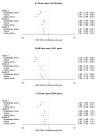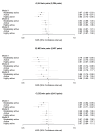The associations of long-term physical activity in adulthood with later biological ageing and all-cause mortality - a prospective twin study
- PMID: 39821867
- PMCID: PMC11799114
- DOI: 10.1007/s10654-024-01200-x
The associations of long-term physical activity in adulthood with later biological ageing and all-cause mortality - a prospective twin study
Abstract
Objectives: The association between leisure-time physical activity (LTPA) and a lower risk of mortality is susceptible to bias from multiple sources. We investigated the potential of biological ageing to mediate the association between long-term LTPA and mortality and whether the methods used to account for reverse causality affect the interpretation of this association.
Methods: Study participants were twins from the older Finnish Twin Cohort (n = 22,750; 18-50 years at baseline). LTPA was assessed using questionnaires in 1975, 1981 and 1990. The mortality follow-up lasted until 2020 and biological ageing was assessed using epigenetic clocks in a subsample (n = 1,153) with blood samples taken during the follow-up. Using latent profile analysis, we identified classes with distinct longitudinal LTPA patterns and studied differences in biological ageing between these classes. We employed survival models to examine differences in total, short-term and long-term all-cause mortality, and multilevel models for twin data to control for familial factors.
Results: We identified four classes of long-term LTPA: sedentary, moderately active, active and highly active. Although biological ageing was accelerated in sedentary and highly active classes, after adjusting for other lifestyle-related factors, the associations mainly attenuated. Physically active classes had a maximum 7% lower risk of total mortality over the sedentary class, but this association was consistent only in the short term. After accounting for familial factors and excluding participants reporting prevalent cardiovascular diseases, LTPA exhibited less favourable associations with mortality.
Conclusion: The association between LTPA and lower all-cause mortality may be largely due to genetic confounding and reverse causality.
Keywords: Biological age; DNA methylation; Lifespan; Mortality; Physical activity.
© 2024. The Author(s).
Conflict of interest statement
Declarations. Ethical approval: Data collection was conducted in accordance with the Declaration of Helsinki. The ethics committees of the University of Helsinki and Helsinki University Central Hospital approved the study protocol (113/E3/2001 and 346/E0/05). Consent to participate: Blood samples for DNA analyses were collected during in-person clinical studies after written informed consent was signed. Data sharing: A subsample of the FTC with DNA methylation age estimates, phenotypes and information on the classes of long-term LTPA will be located in the Biobank of the National Institute for Health and Welfare. All these data will be publicly available for use by qualified researchers following a standardised application procedure (for details on the application process, see the following website: https://thl.fi/en/web/thl-biobank/for-researchers ). Because of the consent given by the study participants and the high degree of identifiability of the twin siblings in Finland, the full cohort data cannot be made publicly available. However, the full cohort data are available through the Institute for Molecular Medicine Finland (FIMM) Data Access Committee (DAC) for authorised researchers with an IRB/ethics approval and an institutionally approved study plan. For more details, please contact the FIMM DAC (fimm-dac@ helsinki.fi). Competing interests: The authors declare no conflicts of interest.
Figures






Update of
-
The associations of long-term physical activity in adulthood with later biological ageing and all-cause mortality - a prospective twin study.medRxiv [Preprint]. 2023 Jun 5:2023.06.02.23290916. doi: 10.1101/2023.06.02.23290916. medRxiv. 2023. Update in: Eur J Epidemiol. 2025 Jan;40(1):107-122. doi: 10.1007/s10654-024-01200-x. PMID: 37333101 Free PMC article. Updated. Preprint.
Similar articles
-
The associations of long-term physical activity in adulthood with later biological ageing and all-cause mortality - a prospective twin study.medRxiv [Preprint]. 2023 Jun 5:2023.06.02.23290916. doi: 10.1101/2023.06.02.23290916. medRxiv. 2023. Update in: Eur J Epidemiol. 2025 Jan;40(1):107-122. doi: 10.1007/s10654-024-01200-x. PMID: 37333101 Free PMC article. Updated. Preprint.
-
Association of Leisure-Time Physical Activity Across the Adult Life Course With All-Cause and Cause-Specific Mortality.JAMA Netw Open. 2019 Mar 1;2(3):e190355. doi: 10.1001/jamanetworkopen.2019.0355. JAMA Netw Open. 2019. PMID: 30848809 Free PMC article.
-
The role of adolescent lifestyle habits in biological aging: A prospective twin study.Elife. 2022 Nov 8;11:e80729. doi: 10.7554/eLife.80729. Elife. 2022. PMID: 36345722 Free PMC article.
-
Associations of occupational and leisure-time physical activity with all-cause mortality: an individual participant data meta-analysis.Br J Sports Med. 2024 Dec 18;58(24):1527-1538. doi: 10.1136/bjsports-2024-108117. Br J Sports Med. 2024. PMID: 39255999 Free PMC article.
-
Physical activity and health: Findings from Finnish monozygotic twin pairs discordant for physical activity.Scand J Med Sci Sports. 2022 Sep;32(9):1316-1323. doi: 10.1111/sms.14205. Epub 2022 Jul 7. Scand J Med Sci Sports. 2022. PMID: 35770444 Free PMC article. Review.
Cited by
-
Genetic Liability to Cardiovascular Disease, Physical Activity, and Mortality: Findings from the Finnish Twin Cohort.Med Sci Sports Exerc. 2024 Oct 1;56(10):1954-1963. doi: 10.1249/MSS.0000000000003482. Epub 2024 May 15. Med Sci Sports Exerc. 2024. PMID: 38768019 Free PMC article.
-
Genetic Liability to Higher Muscle Strength Associates With a Lower Risk of Cardiovascular Disease Mortality in Men Irrespective of Leisure-Time Physical Activity in Adulthood: A Longitudinal Cohort Study.J Am Heart Assoc. 2025 May 6;14(9):e036941. doi: 10.1161/JAHA.124.036941. Epub 2025 Apr 16. J Am Heart Assoc. 2025. PMID: 40240949 Free PMC article.
-
Relationship between physical activity and DNA methylation-predicted epigenetic clocks.NPJ Aging. 2025 Apr 12;11(1):27. doi: 10.1038/s41514-025-00217-0. NPJ Aging. 2025. PMID: 40221397 Free PMC article.
-
Sport and longevity: an observational study of international athletes.Geroscience. 2025 Apr;47(2):1397-1409. doi: 10.1007/s11357-024-01307-9. Epub 2024 Aug 12. Geroscience. 2025. PMID: 39129051 Free PMC article.
-
The association between exercise, activities, and frailty in older Chinese adults: a cross-sectional study based on the Chinese Longitudinal Healthy Longevity Survey (CLHLS) data.BMC Geriatr. 2025 Feb 26;25(1):131. doi: 10.1186/s12877-025-05802-2. BMC Geriatr. 2025. PMID: 40012051 Free PMC article.
References
-
- Blond K, Brinkløv CF, Ried-Larsen M, et al. Association of high amounts of physical activity with mortality risk: a systematic review and meta-analysis. Br J Sports Med. 2020;54:1195–201. 10.1136/bjsports-2018-100393 - PubMed
-
- Yang Y, Dixon-Suen SC, Dugué PA, et al. Physical activity and sedentary behaviour over adulthood in relation to all-cause and cause-specific mortality: a systematic review of analytic strategies and study findings. Int J Epidemiol. 2022;51:641–67. 10.1093/ije/dyab181. - PubMed
Publication types
MeSH terms
Grants and funding
LinkOut - more resources
Full Text Sources
Medical

